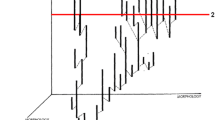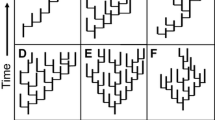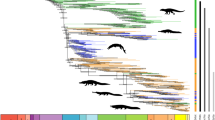Abstract
Adaptive radiations are often invoked anytime clades show significant bursts of diversification, but it is important to not simply assume that any radiating clade constitutes an adaptive radiation. In addition, several highly relevant macroevolutionary concepts including the Turnover Pulse Hypothesis, the Effect Hypothesis, exaptation, and species selection, have not been considered in the adaptive radiations literature. Here, these concepts are integrated into the theory of evolutionary radiations in general, and adaptive radiations in particular, and different types of evolutionary radiations are identified, including geographic radiations. Special emphasis is placed on considering the role that abiotic as opposed to biotic factors may play in motivating diversification during evolutionary radiations. Further, recent paleontological data suggesting that rather than organismal adaptation it may be principally abiotic factors, such as climate change and a taxon’s presence in a geographically complex region, that cause clades to diversify will be described. The fossil record, the source of the initial hallmark examples of adaptive radiation, now appears to show little concrete support for this phenomenon.


Similar content being viewed by others
References
Abe F. R. (2010). The nature of evolutionary radiations with a special focus on Devonian calmoniid trilobites. Ph.D. Dissertation, University of Kansas.
Abe, F. R., & Lieberman, B. S. (2009). The nature of evolutionary radiations: A case study involving Devonian trilobites. Evolutionary Biology, 36, 225–234.
Abe, F. R., & Lieberman, B. S. (2012). Quantifying morphological change during an evolutionary radiation of Devonian trilobites. Paleobiology, 38, 292–307.
Benton, M. J. (1996). Testing the roles of competition and expansion in tetrapod evolution. Proceedings of the Royal Society of London, Biological Sciences, Series B, 263, 641–646.
Bowler, P. J. (1996). Life’s splendid drama. Chicago: University of Chicago Press.
Brooks, D. R., & McLennan, D. A. (1991). Phylogeny, ecology, and behavior. Chicago: University of Chicago Press.
Cadena, C. D., Ricklefs, R. E., Jiménez, I., & Bermingham, E. (2005). Ecology: Is speciation driven by species diversity? Nature, 438, E1–E2.
Coyne, J. A., & Orr, H. A. (2004). Speciation. Sunderland, MA: Sinauer Press.
Cracraft, J. (1982). A nonequilibrium theory for the rate-control of speciation and extinction and the origin of macroevolutionary patterns. Systematic Zoology, 31, 348–365.
Diamond, J. M., Gilpin, M. E., & Mayr, E. (1976). Species-distance relation for birds of the Solomon Archipelago, and the paradox of the great speciators. Proceedings of the National Academy of Sciences, USA, 73, 2160–2164.
Eldredge, N. (1979). Alternative approaches to evolutionary theory. Bulletin of Carnegie Museum of Natural History, 13, 7–19.
Eldredge, N. (1985). Unfinished Synthesis. New York: Oxford University Press.
Eldredge, N. (1989). Macroevolutionary dynamics. New York: McGraw-Hill.
Eldredge, N., & Cracraft, J. (1980). Phylogenetic patterns and the evolutionary process: Method and theory in comparative biology. New York: Columbia University Press.
Eldredge, N., & Gould, S. J. (1972). Punctuated equilibrium: An alternative to phyletic gradualism. In T. J. M. Schopf (Ed.), Models in paleobiology (pp. 82–115). San Francisco: W. H. Freeman.
Emerson, B. C., & Kolm, N. (2005). Species diversity can drive speciation. Nature, 434, 1015–1017.
Futuyma, D. J. (1998). Evolutionary biology (3rd ed.). Sunderland, MA: Sinauer.
Gittenberger, E. (1991). What about non-adaptive radiation? Biological Journal of the Linnean Society, 43, 263–272.
Givnish, T. J. (1997). Adaptive radiation and molecular systematics: Issues and approaches. In T. J. Givnish & K. J. Sytsma (Eds.), Molecular evolution and adaptive radiation (pp. 1–54). Cambridge: Cambridge University Press.
Glor, R. E., Gifford, M. E., Larson, A., Losos, J. B., Rodriguez-Schettino, L., Lara, A. R. C., et al. (2004). Partial island submergence and speciation in an adaptive radiation: a multilocus analysis of the Cuban green anoles. Proceedings of the Royal Society, Biological Sciences, Series B, 271(1554), 2257–2265.
Gould, S. J. (1990). Speciation and sorting as the source of evolutionary trends, or ‘things are seldom what they seem’. In K. J. McNamara (Ed.), Evolutionary trends (pp. 3–27). London: Belhaven Press.
Gould, S. J. (2002). The structure of evolutionary theory. Cambridge, MA: Harvard University Press.
Gould, S. J., & Lewontin, R. C. (1979). The spandrels of San Marco and the Panglossian paradigm: A critique of the adaptationist programme. Proceedings of the Royal Society of London Series B, 205(1161), 581–598.
Gould, S. J., & Vrba, E. S. (1982). Exaptation—A missing term in the science of form. Paleobiology, 8, 4–15.
Grant, P. R., & Grant, B. R. (2008). How and why species multiply: The radiation of Darwin’s finches. Princeton, NJ: Princeton University Press.
Harmon, L. J., Losos, J. B., Davies, T. J., Gillespie, R. G., Gittleman, J. L., Jennings, W. B., et al. (2010). Early bursts of body size and shape evolution are rare in comparative data. Evolution, 64, 2385–2396.
Harmon, L. J., Schulte, J. A., I. I., Larson, A., & Losos, J. B. (2003). Tempo and mode of evolutionary radiation in iguanian lizards. Science, 301(5635), 961–964.
Huxley, J. (1942). Evolution: The modern synthesis. London: Allen & Unwin.
Jablonski, D. (1986). Larval ecology and macroevolution of marine invertebrates. Bulletin of Marine Science, 39, 565–587.
Jablonski, D. (2007). Scale and hierarchy in macroevolution. Palaeontology, 50, 87–109.
Kocher, T. D. (2004). Adaptive evolution and explosive speciation: The cichlid model. Nature Genetics, 5, 288–298.
Lieberman, B. S. (1993). Systematics and biogeography of the ‘‘Metacryphaeus Group’’ Calmoniidae (Trilobita, Devonian) with comments on adaptive radiations and the geological history of the Malvinokaffric realm. Journal of Paleontology, 67, 549–570.
Lieberman B. S. (1999). Turnover pulse in trilobites during the Acadian Orogeny. In Proceedings of the Appalachian Biogeography Symposium. Virginia Museum of Natural History Special Publications Number 7:99–108.
Lieberman, B. S. (2000). Paleobiogeography. New York: Kluwer Academic.
Lieberman, B. S. (2001). A test of whether rates of speciation were unusually high during the Cambrian radiation. Proceedings of the Royal Society, Biological Sciences, Series B, 268, 1707–1714.
Lieberman, B. S. (2003). Taking the pulse of the Cambrian radiation. Journal of Integrative and Comparative Biology, 43, 229–237.
Lieberman, B. S., Allmon, W. D., & Eldredge, N. (1993). Levels of selection and macroevolutionary patterns in the turritellid gastropods. Paleobiology, 19, 205–215.
Lieberman, B. S., Edgecombe, G. D., & Eldredge, N. (1991). Systematics and biogeography of the ‘‘Malvinella Group’’, Calmoniidae (Trilobita, Devonian). Journal of Paleontology, 65, 824–843.
Lieberman, B. S., & Vrba, E. S. (1995). Hierarchy theory, selection, and sorting. BioScience, 45(6), 394–399.
Lieberman, B. S., & Vrba, E. S. (2005). Stephen Jay Gould on species selection: 30 years of insight. Paleobiology, 31(2, supplement), 113–121.
Losos, J. B. (2009). Lizards in an evolutionary tree: Ecology and adaptive radiation of anoles. Berkeley, CA: University of California Press.
Losos, J. B., & Glor, R. E. (2003). Phylogenetic comparative methods and the geography of speciation. Trends in Ecology & Evolution, 18, 220–227.
Losos, J. B., & Miles, D. B. (2002). Testing the hypothesis that a clade has adaptively radiated: Iguanid lizard clades as a case study. American Naturalist, 160, 147–157.
Lovette, I. J., Bermingham, E., & Ricklefs, R. E. (2001). Clade-specific morphological diversification and adaptive radiation in Hawaiian songbirds. Proceedings of the Royal Society, Biological Sciences, Series B, 269, 37–42.
Maguire, K. C., & Stigall, A. L. (2008). Paleobiogeography of Miocene Equinae of North America: A phylogenetic biogeographic analysis of the relative roles of climate, vicariance, and dispersal. Palaeogeography, Palaeoclimatology, Palaeoecology, 267, 175–184.
Mayr, E. (1942). Systematics and the origin of species. New York: Columbia University Press.
Morrone, J. J. (2008). Evolutionary biogeography: An integrative approach with case studies. New York: Columbia University Press.
Moyle, R. G., Filardi, C. E., Smith, C. F., & Diamond, J. (2009). Explosive Pleistocene diversification and hemispheric expansion of a “great speciator”. Proceedings of the National Academy of Sciences, USA, 106(6), 1863–1868.
Myers, C., & Lieberman, B. S. (2011). Sharks that pass in the night: Using GIS to investigate competition in the Cretaceous Western Interior Seaway. Proceedings of the Royal Society, Biological Sciences, Series B, 278(1706), 681–689.
Nee, S. (2006). Birth-death models in macroevolution. Annual Review of Ecology, Evolution, and Systematics, 37, 1–17.
Olson, M. E., & Arroyo-Santos, A. (2009). Thinking in continua: Beyond the ‘adaptive radiation’ metaphor. Bioessays, 31(12), 1337–1346.
Osborn, H. (1902). The law of adaptive radiation. American Naturalist, 36, 353–363.
Rabosky, D., & McCune, A. R. (2010). Reinventing species selection with molecular phylogenies. Trends in Ecology & Evolution, 25, 68–74.
Ricklefs, R. E., & Miles, D. B. (1994). Ecological and evolutionary inferences from morphology: An ecological perspective. In P. C. Wainwright & S. M. Reilly (Eds.), Ecological morphology: Integrative organismal biology (pp. 13–41). Chicago: University of Chicago Press.
Rode, A. L., & Lieberman, B. S. (2005). Integrating biogeography and evolution using phylogenetics and PaleoGIS: A case study involving Devonian crustaceans. Journal of Paleontology, 79, 267–276.
Rundell, R. J., & Price, T. D. (2009). Adaptive radiation, nonadaptive radiation, ecological speciation and nonecological speciation. Trends in Ecology & Evolution, 24(7), 394–399.
Sanderson, M., & Donoghue, M. (1996). Reconstructing shifts in diversification rates on phylogenetic trees. Trends in Ecology & Evolution, 11, 15–20.
Savolainen, V., Anstett, M.-C., Lexer, C., Hutton, I., Clarkson, J. J., Norup, M. V., et al. (2006). Sympatric speciation in palms on an oceanic island. Nature, 44, 210–213.
Schluter, D. (2000). The ecology of adaptive radiation. Oxford: Oxford University Press.
Seehausen, O. (2006). African cichlid fish: A model system in adaptive radiation research. Proceedings of the Royal Society, Biological Sciences, Series B, 273(1597), 1987–1998.
Sibley, C. G., & Ahlquist, J. E. (1990). Phylogeny and classification of birds. New Haven, CT: Yale University Press.
Simpson, G. G. (1944). Tempo and mode in evolution. New York: Columbia University Press.
Simpson, G. G. (1953). The major features of evolution. New York: Columbia University Press.
Stanley, S. M. (1979). Macroevolution, pattern and process. San Francisco: W. H. Freeman.
Stigall, A. L. (2010). Speciation decline during the Late Devonian biodiversity crisis related to species invasions. PLoS One, 5(12), e15584.
Theiler, G. R., Gardenal, C. N., & Blanco, A. (1999). Patterns of evolution in Graomys griseoflavus (Rodentia, Muridae). IV. A case of rapid speciation. Journal of Evolutionary Biology, 12, 970–979.
Vogler, A., & Goldstein, P. (1997). Adaptive radiation and taxon cycles in North American tiger beetles: A cladistic perspective. In T. J. Givnish & K. J. Sytsma (Eds.), Molecular evolution and adaptive radiation (pp. 353–373). Cambridge: Cambridge University Press.
Vrba, E. S. (1984). What is species selection? Systematic Zoology, 33, 318–328.
Vrba, E. S. (1985). Environment and evolution: Alternative causes of the temporal distribution of evolutionary events. South African Journal of Science, 81, 229–236.
Vrba, E. S. (1987). Ecology in relation to speciation rates: Some case histories of Miocene-Recent mammal clades. Evolutionary Ecology, 1, 283–300.
Vrba, E. S. (1989). Levels of selection and sorting with special reference to the species level. Oxford Surveys in Evolutionary Biology, 6, 111–168.
Vrba, E. S. (1992). Mammals as a key to evolutionary theory. Journal of Mammalogy, 73, 1–28.
Vrba, E. S., & Eldredge, N. (1984). Individuals, hierarchies and processes: Towards a more complete evolutionary theory. Paleobiology, 10, 146–171.
Vrba, E. S., & Gould, S. J. (1986). The hierarchical expansion of sorting and selection: Sorting and selection cannot be equated. Paleobiology, 12, 217–228.
Whittaker, R. J., Ladle, R. J., Araújo, M. B., Fernández-Palacios, J. M., Delgado, J. D., & Arévalo, J. R. (2007). The island immaturity—Speciation pulse model of island evolution: An alternative to the “diversity begets diversity” model. Ecography, 30, 321–327.
Wiley, E. O. (1981). Phylogenetics. New York: Wiley.
Wiley, E. O., & Lieberman, B. S. (2011). Phylogenetics (2nd ed.). New York: Wiley.
Wiley, E. O., & Mayden, R. L. (1985). Species and speciation in phylogenetic systematics, with examples from the North American fish fauna. Annals of the Missouri Botanical Garden, 72, 596–635.
Yang, W., Cerling, T. E., & MacFadden, B. J. (1994). Fossil horses and carbon isotopes: New evidence for Cenozoic dietary, habitat, and ecosystem changes in North America. Palaeogeography, Palaeoclimatology, Palaeoecology, 107, 279–2669.
Yoder, J., Clancey, E., Des Roches, S., Eastman, J., Gentry, L., Godsoe, W., et al. (2010). Ecological opportunity and the origin of adaptive radiations. Journal of Evolutionary Biology, 23, 1581–1596.
Acknowledgments
Thanks to Maria Pia Miglietta, Francesco Santini, and Anuschka Faucci for inviting me to participate in this special issue of the journal. Thanks to Francine Abe and Ed Wiley for discussions on the subject of adaptive radiations, and to Rob Moyle, Katherine Willmore, and two anonymous reviewers for comments on an earlier version of this paper. This research was supported by NSF-DEB-0716162.
Author information
Authors and Affiliations
Corresponding author
Rights and permissions
About this article
Cite this article
Lieberman, B.S. Adaptive Radiations in the Context of Macroevolutionary Theory: A Paleontological Perspective. Evol Biol 39, 181–191 (2012). https://doi.org/10.1007/s11692-012-9165-8
Received:
Accepted:
Published:
Issue Date:
DOI: https://doi.org/10.1007/s11692-012-9165-8




